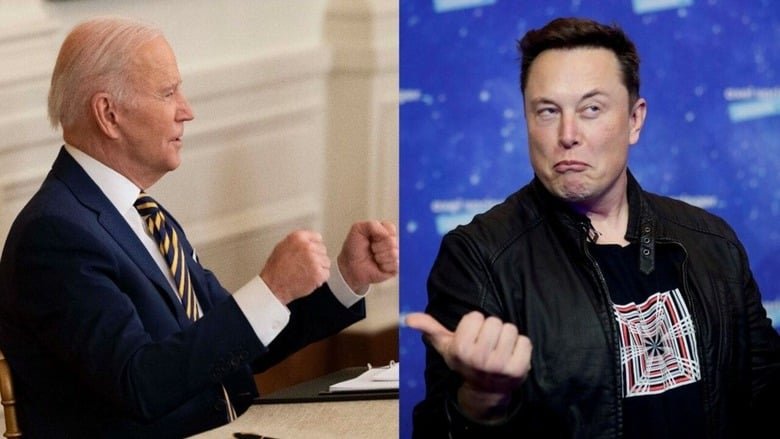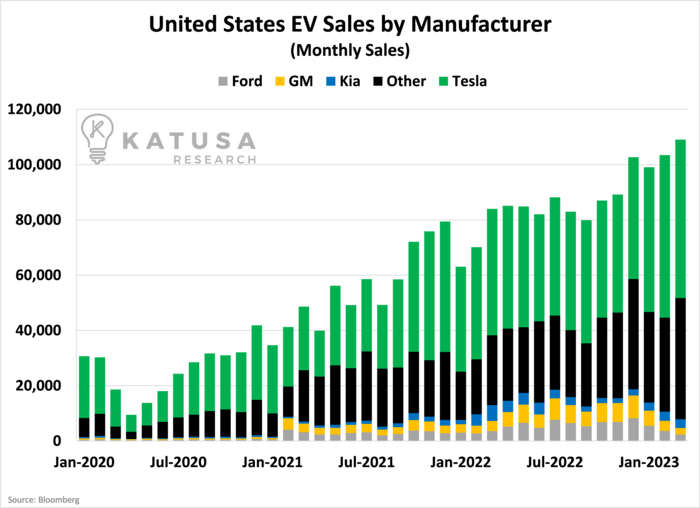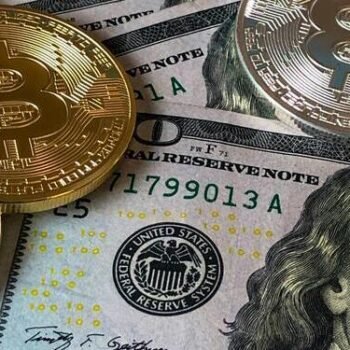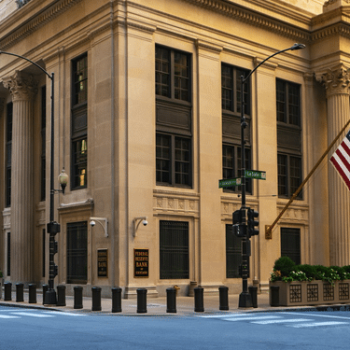
“Or you can just buy a Tesla.” That was Elon Musk’s terse response to Biden’s plan to build 500,000 EV charging stations across the U.S. The public feud started a year and a half earlier, in August 2021, when President Biden hosted an EV manufacturer summit at the White House.
- Tesla is the dominant U.S. EV manufacturer, manufacturing two out of every three U.S. EVs in 2022.
No other company comes close.

From January 2020 through March 2023, there have been 2.2 million EVs sold in the United States. Tesla accounts for roughly 54% of all sales. Yet President Biden passed over Tesla, choosing instead to meet with only Ford and GM. “It seems odd Tesla wasn’t invited,” Musk tweeted.
Six months later, President Biden tweeted another Tesla snub: “Companies like GM and Ford are building more electric vehicles here at home than ever before.” Musk shot back twice, with his typical elementary panache:
Sitting presidents generally dislike being called damp sock puppets.
So two weeks later, the Biden administration announced the National Electric Vehicle Infrastructure Program (NEVI). It included $7.5 billion in funding for the buildout of EV charging across the U.S.
But there was one crucial stipulation… To qualify for funding, EV chargers would have to work with EVs “from more than one automaker.” Famously, Tesla’s Supercharger network with ultra-fast chargers spanning the U.S., only works with Tesla’s.
It wasn’t just directly aimed at excluding Tesla from funding; the program was an attempt to dethrone Tesla as the de facto EV monopoly in the U.S.
A Charging Standard By Any Other Name
Meanwhile, Tesla prepared a serious counterattack…
When Tesla began manufacturing EVs in 2012, there was no EV charging standard. So Tesla created its own, simply dubbed the “Tesla charging connector.” And now it was time for a brilliantly strategic rebrand: the “North American Charging Standard,” or NACS. Tesla made the newly minted NACS standard completely open and encouraged any manufacturer or charging network to make chargers or cars with NACS. Now, Musk knows that the best time to play a trump card is immediately after your opponent plays theirs. Biden played the CCS trump card, thinking he could put NACS out of business. There’s only one problem…
- Musk’s trump card is not a charging standard. It’s a massive charging network.
Adopt or Die
The number one concern with buying an EV? Charging. But no car manufacturer other than Tesla has access to a nationwide fast-charging network. Building out a similar network would take years and cost billions. Those are years and billions car companies don’t have.
- Ford, for example, is investing its entire market cap into EVs—and losing $3 billion a year doing so.
Which is why Ford was the first domino to fall.In May 2023, Ford committed to integrating NACS ports into their EVs. The move instantly doubled the number of fast chargers available to Ford drivers nationwide. In June 2023, GM also agreed to adopt NACS. Elon had successfully locked 75% of U.S.-manufactured EVs into Tesla’s new charging standard. And the two companies Biden used to taunt Tesla – GM and Ford – were now indebted to Tesla. More importantly, a tipping point had been reached.
- Rivian, Polestar, and Volvo announced in quick succession that they would also be adopting NACS charge ports.
- The major U.S. chargepoint operators, including Blink, Chargepoint, FLO, EVGo, and Electrify America, have all already committed to building out NACS chargers.
CCS support in North America is fading fast, which means that any auto manufacturer that refuses to make the switch will all but guarantee their buyers will have difficulty finding chargers in the future.
- Far from the government funding putting Tesla out of business, Tesla is now able to use the government funding to put the government standard out of business.
On June 27, 2023, SAE International announced it will move to standardize the NACS connector. The North American Charging Standard is now, officially, the charging standard of North America.
Never Bet Against America*(*Unless You’re Betting on Elon Musk)
Several states, including Texas and Kentucky, are bucking federal authority and joining Team Tesla. They require chargers to provide NACS access to receive federal funding. So, let’s review:
- Tesla ended up with access to the $7.5 billion in federal government funding.
- Tesla established its own charging standard as the de facto North American charging standard.
- And Tesla eliminated its EV charging network competition once and for all.
All in one fell swoop. And that’s not all. Within a decade, the move to NACS is expected to be making Tesla an extra $5 billion in annual revenue. Tesla is investing in continuously expanding its charging network, extending its incredible moat. Elon won, Joe. It really would’ve been easier to buy a Tesla. Regards,Marin Katusa P.S. The race to net zero is fueled by Governments and accelerating fast by major corporates. It will affect major resources and energy mixes, everything from carbon to hydrogen, lithium to zinc. This is an exciting time for investors.
Details and Disclosures
Investing can have large potential rewards, but it can also have large potential risks. You must be aware of the risks and be willing to accept them in order to invest in financial instruments, including stocks, options, and futures. Katusa Research makes every best effort in adhering to publishing exemptions and securities laws. By reading this, you agree to all of the following: You understand this to be an expression of opinions and NOT professional advice. You are solely responsible for the use of any content and hold Katusa Research, and all partners, members, and affiliates harmless in any event or claim. If you purchase anything through a link in this email, you should assume that we have an affiliate relationship with the company providing the product or service that you purchase, and that we will be paid in some way. We recommend that you do your own independent research before purchasing anything.






